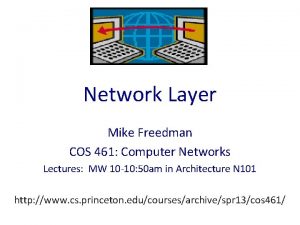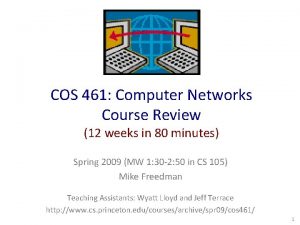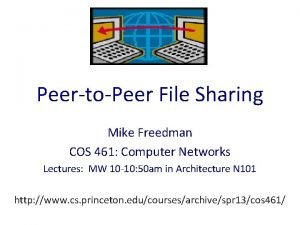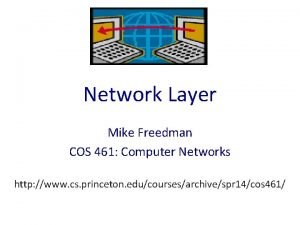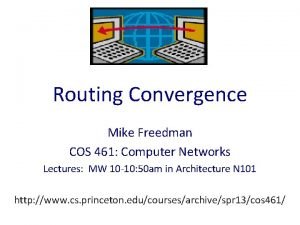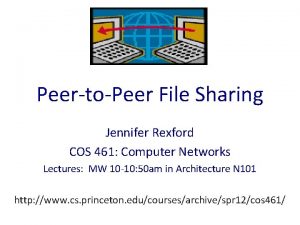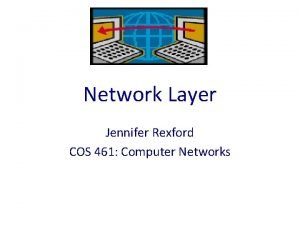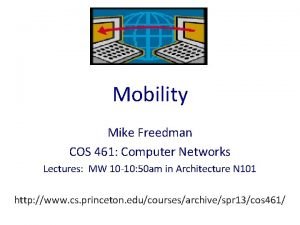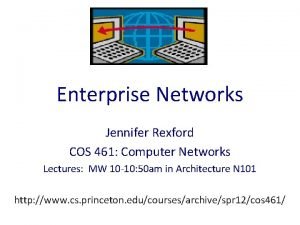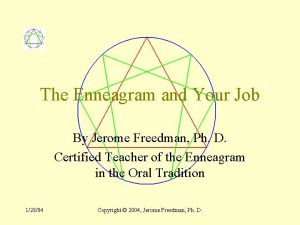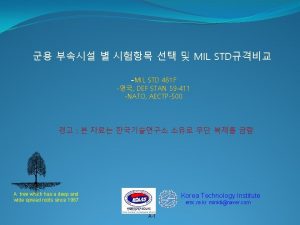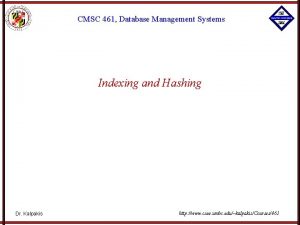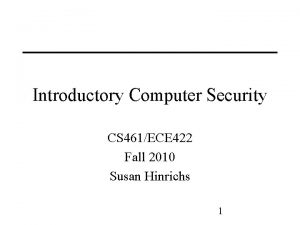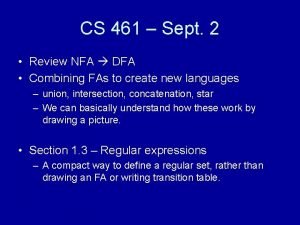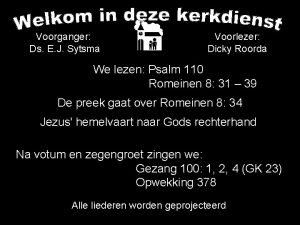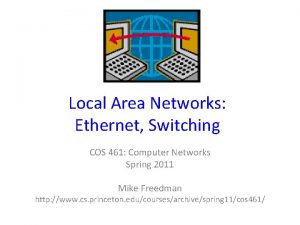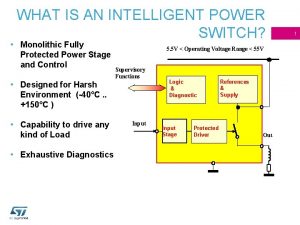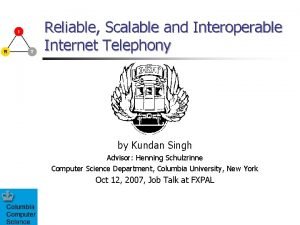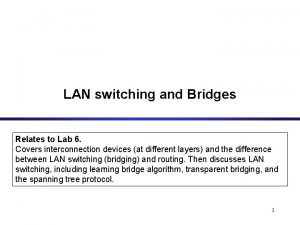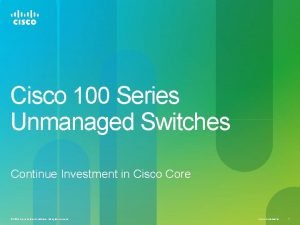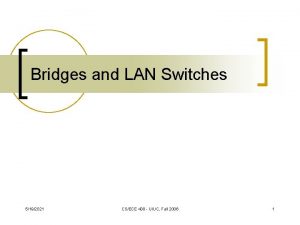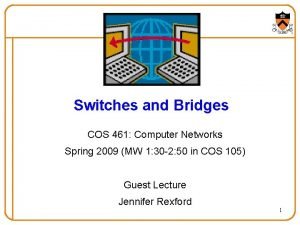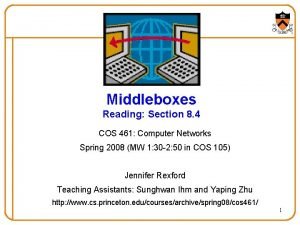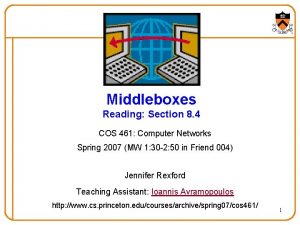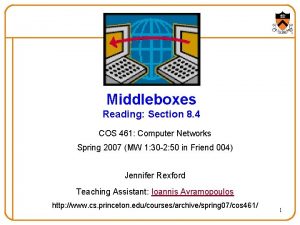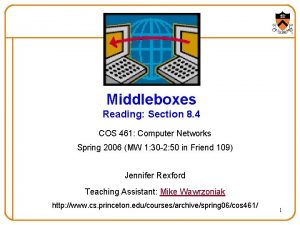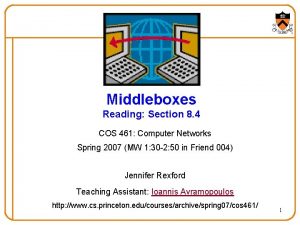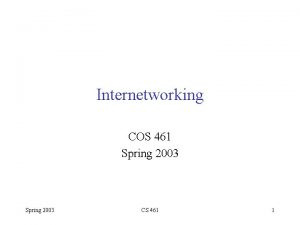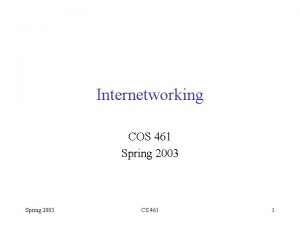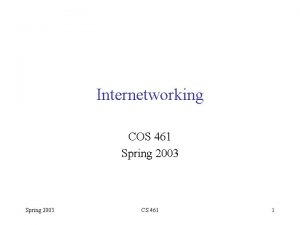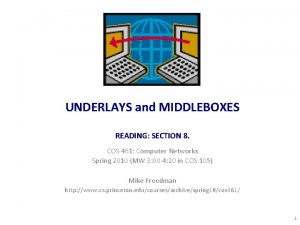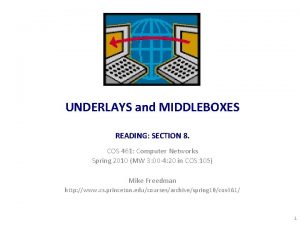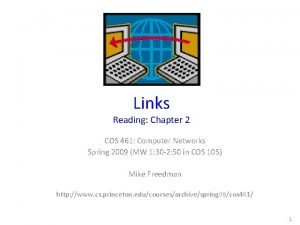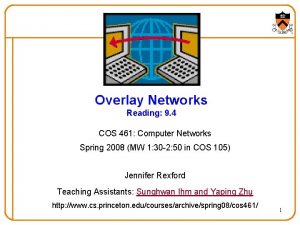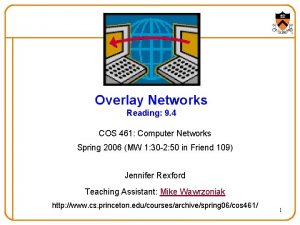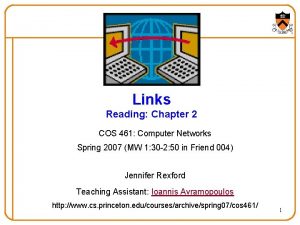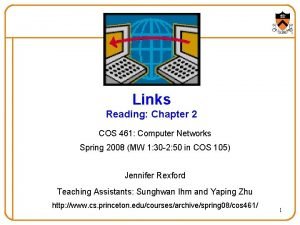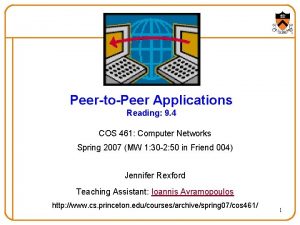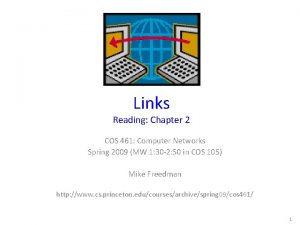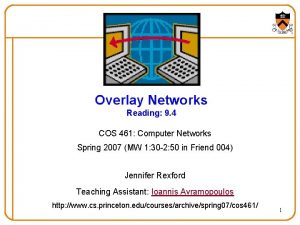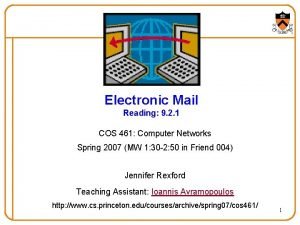Switches Reading Section 3 2 COS 461 Computer



































- Slides: 35

Switches Reading: Section 3. 2 COS 461: Computer Networks Spring 2007 (MW 1: 30 -2: 50 in Friend 004) Jennifer Rexford Teaching Assistant: Ioannis Avramopoulos http: //www. cs. princeton. edu/courses/archive/spring 07/cos 461/ 1

Midterm Exam • Location – Same room as lectures (Friend 004) • Time – 1: 30 pm-2: 50 pm on Wednesday March 14 – Usual class time • Open book, notes, slides, etc. – Just no computer, PDA, calculator, etc. • Preparation – Required reading from textbook, plus lecture notes – Practice exams, plus questions in the text book 2

Goals of Today’s Lecture • Devices that shuttling packets at different layers – Repeaters and hubs – Bridges and switches – Routers • Switch protocols and mechanisms – Dedicated access and full-duplex transfers – Cut-through switching – Self learning of the switch table – Spanning trees • Virtual LANs (VLANs) 3

Shuttling Data at Different Layers • Different devices switch different things – Physical layer: electrical signals (repeaters and hubs) – Link layer: frames (bridges and switches) – Network layer: packets (routers) Application gateway Transport gateway Router Frame Packet TCP header User data Bridge, switch Repeater, hub 4

Physical Layer: Repeaters • Distance limitation in local-area networks – Electrical signal becomes weaker as it travels – Imposes a limit on the length of a LAN • Repeaters join LANs together – Analog electronic device – Continuously monitors electrical signals on each LAN – Transmits an amplified copy 5

Physical Layer: Hubs • Joins multiple input lines electrically – Designed to hold multiple line cards – Do not necessarily amplify the signal • Very similar to repeaters – Also operates at the physical layer hub hub 6

Limitations of Repeaters and Hubs • One large collision domain – Every bit is sent everywhere – So, aggregate throughput is limited – E. g. , three departments each get 10 Mbps independently – … and then connect via a hub and must share 10 Mbps • Cannot support multiple LAN technologies – Does not buffer or interpret frames – So, can’t interconnect between different rates or formats – E. g. , 10 Mbps Ethernet and 100 Mbps Ethernet • Limitations on maximum nodes and distances – Does not circumvent the limitations of shared media – E. g. , still cannot go beyond 2500 meters on Ethernet 7

Link Layer: Bridges • Connects two or more LANs at the link layer – Extracts destination address from the frame – Looks up the destination in a table – Forwards the frame to the appropriate LAN segment • Each segment is its own collision domain host host Bridge host 8

Link Layer: Switches • Typically connects individual computers – A switch is essentially the same as a bridge – … though typically used to connect hosts, not LANs • Like bridges, support concurrent communication – Host A can talk to C, while B talks to D B A C switch D 9

Dedicated Access and Full Duplex • Dedicated access – Host has direct connection to the switch – … rather than a shared LAN connection • Full duplex – Each connection can send in both directions – Host sending to switch, and host receiving from switch – E. g. , in 10 Base. T and 100 Base T • Completely avoids collisions – Each connection is a bidirectional point-to-point link – No need for carrier sense, collision detection, and so on 10

Bridges/Switches: Traffic Isolation • Switch breaks subnet into LAN segments • Switch filters packets – Frame only forwarded to the necessary segments – Segments become separate collision domains switch/bridge collision domain hub 11

Advantages Over Hubs/Repeaters • Only forwards frames as needed – Filters frames to avoid unnecessary load on segments – Sends frames only to segments that need to see them • Extends the geographic span of the network – Separate collision domains allow longer distances • Improves privacy by limiting scope of frames – Hosts can “snoop” the traffic traversing their segment – … but not all the rest of the traffic • Applies carrier sense and collision detection – Does not transmit when the link is busy – Applies exponential back-off after a collision • Joins segments using different technologies 12

Disadvantages Over Hubs/Repeaters • Delay in forwarding frames – Bridge/switch must receive and parse the frame – … and perform a look-up to decide where to forward – Storing and forwarding the packet introduces delay – Solution: cut-through switching • Need to learn where to forward frames – Bridge/switch needs to construct a forwarding table – Ideally, without intervention from network administrators – Solution: self-learning • Higher cost – More complicated devices that cost more money 13

Motivation For Cut-Through Switching • Buffering a frame takes time – Suppose L is the length of the frame – And R is the transmission rate of the links – Then, receiving the frame takes L/R time units • Buffering delay can be a high fraction of total delay – Propagation delay is small over short distances – Making buffering delay a large fraction of total – Analogy: large group walking through NYC A B switches 14

Cut-Through Switching • Start transmitting as soon as possible – Inspect the frame header and do the look-up – If outgoing link is idle, start forwarding the frame • Overlapping transmissions – Transmit the head of the packet via the outgoing link – … while still receiving the tail via the incoming link – Analogy: different folks crossing different intersections A B switches 15

Motivation For Self Learning • Switches forward frames selectively – Forward frames only on segments that need them • Switch table – Maps destination MAC address to outgoing interface – Goal: construct the switch table automatically B A C switch D 16

Self Learning: Building the Table • When a frame arrives – Inspect the source MAC address – Associate the address with the incoming interface – Store the mapping in the switch table – Use a time-to-live field to eventually forget the mapping Switch learns how to reach A. B A C D 17

Self Learning: Handling Misses • When frame arrives with unfamiliar destination – Forward the frame out all of the interfaces – … except for the one where the frame arrived – Hopefully, this case won’t happen very often When in doubt, shout! B A C D 18

Switch Filtering/Forwarding When switch receives a frame: index switch table using MAC dest address if entry found for destination then{ if dest on segment from which frame arrived then drop the frame else forward the frame on interface indicated } else flood forward on all but the interface on which the frame arrived 19

Flooding Can Lead to Loops • Switches sometimes need to broadcast frames – Upon receiving a frame with an unfamiliar destination – Upon receiving a frame sent to the broadcast address • Broadcasting is implemented by flooding – Transmitting frame out every interface – … except the one where the frame arrived • Flooding can lead to forwarding loops – E. g. , if the network contains a cycle of switches – Either accidentally, or by design for higher reliability 20

Solution: Spanning Trees • Ensure the topology has no loops – Avoid using some of the links when flooding – … to avoid forming a loop • Spanning tree – Sub-graph that covers all vertices but contains no cycles – Links not in the spanning tree do not forward frames 21

Constructing a Spanning Tree • Need a distributed algorithm – Switches cooperate to build the spanning tree – … and adapt automatically when failures occur • Key ingredients of the algorithm – Switches need to elect a “root” The switch with the smallest identifier root – Each switch identifies if its interface is on the shortest path from the root And it exclude from the tree if not – Messages (Y, d, X) From node X Claiming Y is the root And the distance is d One hop Three hops 22

Steps in Spanning Tree Algorithm • Initially, each switch thinks it is the root – Switch sends a message out every interface – … identifying itself as the root with distance 0 – Example: switch X announces (X, 0, X) • Switches update their view of the root – Upon receiving a message, check the root id – If the new id is smaller, start viewing that switch as root • Switches compute their distance from the root – Add 1 to the distance received from a neighbor – Identify interfaces not on a shortest path to the root – … and exclude them from the spanning tree 23

Example From Switch #4’s Viewpoint • Switch #4 thinks it is the root – Sends (4, 0, 4) message to 2 and 7 • Then, switch #4 hears from #2 1 – Receives (2, 0, 2) message from 2 – … and thinks that #2 is the root – And realizes it is just one hop away • Then, switch #4 hears from #7 – Receives (2, 1, 7) from 7 – And realizes this is a longer path – So, prefers its own one-hop path – And removes 4 -7 link from the tree 3 5 2 4 7 6 24

Example From Switch #4’s Viewpoint • Switch #2 hears about switch #1 – Switch 2 hears (1, 1, 3) from 3 – Switch 2 starts treating 1 as root – And sends (1, 2, 2) to neighbors 1 • Switch #4 hears from switch #2 – Switch 4 starts treating 1 as root – And sends (1, 3, 4) to neighbors • Switch #4 hears from switch #7 – Switch 4 receives (1, 3, 7) from 7 – And realizes this is a longer path – So, prefers its own three-hop path – And removes 4 -7 Iink from the tree 3 5 2 4 7 6 25

Robust Spanning Tree Algorithm • Algorithm must react to failures – Failure of the root node Need to elect a new root, with the next lowest identifier – Failure of other switches and links Need to recompute the spanning tree • Root switch continues sending messages – Periodically reannouncing itself as the root (1, 0, 1) – Other switches continue forwarding messages • Detecting failures through timeout (soft state!) – Switch waits to hear from others – Eventually times out and claims to be the root See Section 3. 2. 2 in the textbook for details and another example 26

Evolution Toward Virtual LANs • In the olden days… – Thick cables snaked through cable ducts in buildings – Every computer they passed was plugged in – All people in adjacent offices were put on the same LAN – Independent of whether they belonged together or not • More recently… – Hubs and switches changed all that – Every office connected to central wiring closets – Often multiple LANs (k hubs) connected by switches – Flexibility in mapping offices to different LANs Group users based on organizational structure, rather than the physical layout of the building. 27

Why Group by Organizational Structure? • Security – Ethernet is a shared media – Any interface card can be put into “promiscuous” mode – … and get a copy of all of the traffic (e. g. , midterm exam) – So, isolating traffic on separate LANs improves security • Load – Some LAN segments are more heavily used than others – E. g. , researchers running experiments get out of hand – … can saturate their own segment and not the others – Plus, there may be natural locality of communication – E. g. , traffic between people in the same research group 28

People Move, and Roles Change • Organizational changes are frequent – E. g. , faculty office becomes a grad-student office – E. g. , graduate student becomes a faculty member • Physical rewiring is a major pain – Requires unplugging the cable from one port – … and plugging it into another – … and hoping the cable is long enough to reach – … and hoping you don’t make a mistake • Would like to “rewire” the building in software – The resulting concept is a Virtual LAN (VLAN) 29

Example: Two Virtual LANs RO RO O Red VLAN and Orange VLAN Bridges forward traffic as needed 30

Example: Two Virtual LANs R RO O R R O O R R Red VLAN and Orange VLAN Switches forward traffic as needed 31

Making VLANs Work • Bridges/switches need configuration tables – Saying which VLANs are accessible via which interfaces • Approaches to mapping to VLANs – Each interface has a VLAN color Only works if all hosts on same segment belong to same VLAN – Each MAC address has a VLAN color Useful when hosts on same segment belong to different VLANs Useful when hosts move from one physical location to another • Changing the Ethernet header – Adding a field for a VLAN tag – Implemented on the bridges/switches – … but can still interoperate with old Ethernet cards 32

Moving From Switches to Routers • Advantages of switches over routers – Plug-and-play – Fast filtering and forwarding of frames – No pronunciation ambiguity (e. g. , “rooter” vs. “rowter”) • Disadvantages of switches over routers – Topology is restricted to a spanning tree – Large networks require large ARP tables – Broadcast storms can cause the network to collapse 33

Comparing Hubs, Switches, Routers Hub/ Bridge/ Router Traffic isolation Repeater Switch no yes Plug and Play yes no Efficient routing no no yes Cut through yes no 34

Conclusion • Shuttling data from one link to another – Bits, frames, packets, … – Repeaters/hubs, bridges/switches, routers, … • Key ideas in switches – Cut-through switching – Self learning of the switch table – Spanning trees – Virtual LANs (VLANs) • Next time: midterm exam • After the break – Routing – Application-level protocols 35
 Cos 461
Cos 461 Cos 461
Cos 461 Cos 461
Cos 461 Cos 461
Cos 461 Cos 461
Cos 461 Cos 461
Cos 461 Cos 461
Cos 461 Cos 461
Cos 461 Cos 461
Cos 461 Cos
Cos Cos 461
Cos 461 While reading activities
While reading activities 461 enneagram
461 enneagram Mil std 461b
Mil std 461b Cmsc 461
Cmsc 461 Cs 461 uiuc
Cs 461 uiuc Cs 461
Cs 461 Ccna voice 640-461 pdf
Ccna voice 640-461 pdf Kkk 461
Kkk 461 Opwekking 461 tekst
Opwekking 461 tekst Mil std 461 464
Mil std 461 464 Icvm 461/07
Icvm 461/07 Area 461
Area 461 Cpsc 422
Cpsc 422 Celebrated on march 17
Celebrated on march 17 Opwekking 461
Opwekking 461 Contabilitatea tva
Contabilitatea tva Intelligent power switch
Intelligent power switch Three generations of packet switches
Three generations of packet switches Kundan switches models
Kundan switches models Which type of reaction
Which type of reaction Bridges vs switches
Bridges vs switches Rv220w dual gigabit wan vpn router
Rv220w dual gigabit wan vpn router Cisco 100 series switches
Cisco 100 series switches Bridges vs switches
Bridges vs switches Electro-pneumatic circuit
Electro-pneumatic circuit

